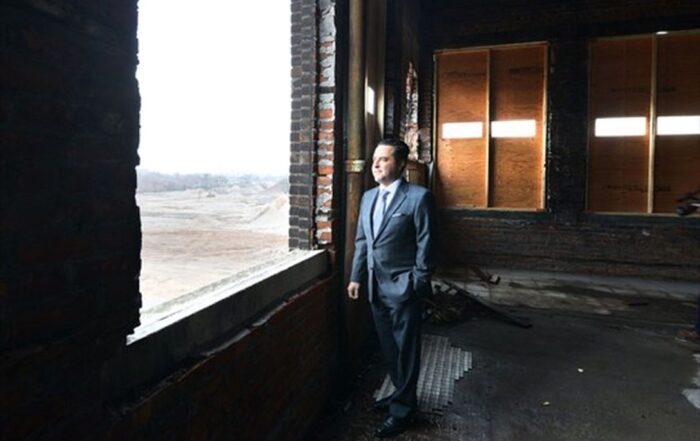Residents in the old homes that line Mars Avenue stare out their windows at a barren landscape that resembles the red planet.
In September of 2012, a demo crew started to decimate the long mothballed Studebaker factory, a teardown that lasted about a year.
Tony Perri, who has lived on Mars Avenue for about 20 years, is glad the factory is gone.
“It looks nicer. The airflow’s a lot better,” Perri said during a recent blustery afternoon in the northern industrial neighbourhood.
But he’s also tired of looking at 26 acres of emptiness.
“Looking at this sea of gravel, we figured something would have been done by now. It just seems to be a standstill, and it’s starting to become annoying.”
Developer Sergio Manchia prefers the word “anxious” when describing the wait to lay out a “pristine” industrial park “in the heart of the city.”
“It’s not up in the Glanbrook area; it’s not in Ancaster,” says Manchia, wearing a neatly pressed suit and polished dress shoes while trudging through the mucky site.
“They’re doing great, fantastic, great,” he adds, “but I’m really focused on bringing some new stuff downtown.”
Tearing down all but 30,000 of the 740,000 square feet of the Studebaker factory was a tough slog, but remediating the brownfield will be tougher, acknowledges Manchia.
His company, UrbanCore Developments, is developing the property in collaboration with landowner DCR Holdings.
“It’s not a quick process,” he says, but the team can see “some light at the end of the tunnel.”
Manchia, also a professional planner and associate with IBI Group, has brought old buildings back to life before.
Some of his work includes the Annex Lofts in a former Eaton’s warehouse on Rebecca Street and the Garfield Lofts, condos in what used to be the CKOC and Bell Canada building on Garfield Street.
Manchia says he wants to draw “more sustainable” uses, such as technology and health-care-related companies, to the new industrial park.
With more than 50 per cent of the 18 lots already “spoken for,” he hopes to break ground this summer, depending on how long remediation takes.
Manchia and his consultant are scheduled to address city officials in January about the project’s record of site condition, a requirement for municipal grants under the city’s Environmental and Remediation and Site Enhancement (ERASE) program.
The Studebaker factory operated on Mars Avenue from 1948 to 1966.
But the 1902 building was also home to Otis Elevators, weapons manufacturing during the First and Second World Wars and Trebor-Allen Candy. Otis bought the building back from Studebaker in 1969 and operated there until 1987.
Manchia has left 30,000 feet of the Otis wing standing at the corner of Victoria Avenue and Ferrie Street.
The plan is to turn it into three floors of modern office space by using much of the original wood and brickwork. Original elevator mechanisms and cars will also help maintain that retro-industrial flavour.
Manchia’s project will alleviate an industrial land crunch in Hamilton, a city official working on the file says.
“One of the key issues that we have right now is that our vacancy rate for industrial buildings is about 1.3 per cent right now,” said Norm Schleehahn, the city’s business development manager.
The new business park will be well situated near major thoroughfares such as Burlington Street and the QEW, Schleehahn added.
The city struggled to attract players to the sprawling Studebaker footprint. Two proposals – one involving a movie studio and the second a recreation facility – went nowhere.
“It was very dysfunctional by today’s standards. You couldn’t get one large user in there,” Schleehahn said.
Ward 3 Councillor Bernie Morelli said it was sad to watch the old factory’s demise over time.
“I’ve been hoping to get this cleaned up for some time.”
Morelli is using some of his ward’s area rating funds to purchase an acre of land to expand a community park at the Wentworth Street North end of the development. The developer has also kicked in a half acre.
While frustrated by the false starts, Morelli is confident Manchia’s project is the real deal.
“Obviously, he’s a fair amount along the way,” the councillor said. “This is not even close to what the last one was.”
The cleanup job
Contaminants on the Studebaker site are what you’d expect from old foundries and metalworking sites, says Carol Mitchell, an environmental engineer UrbanCore contracted for what she calls one of the largest brownfield projects in Hamilton’s history.
Soil and groundwater sampling revealed mostly metals, petroleum hydrocarbons (PHCs) and polycyclic aromatic hydrocarbons (PAHs) from historical fuel use, such as coal, Mitchell noted in an email to The Spectator.
In the summer of 2012, councillors approved a $650,000 grant – under the city’s ERASE program – to demolish the building.
Under the program, the project is also eligible for a tax rebate, the total of which hasn’t yet been determined, the city noted in a recent report on the project.
The brownfield program requires developers to produce a record of site condition, obtained after remediation work is finished.
The site, which is industrial and will remain “employment land,” will meet provincial standards for cleanup, Mitchell says.
In January, she’s scheduled to address council about having a risk assessment approved by a peer reviewer rather than going through the Ministry of the Environment.
“By doing so, we don’t save any substantial costs for the cleanup, but we save a lot of time,” Mitchell said.
If council accepts that route, she estimates the project team will take 10 months to clean up the property. In the meantime, development can start on some lots because they’re already clean, Mitchell added.

